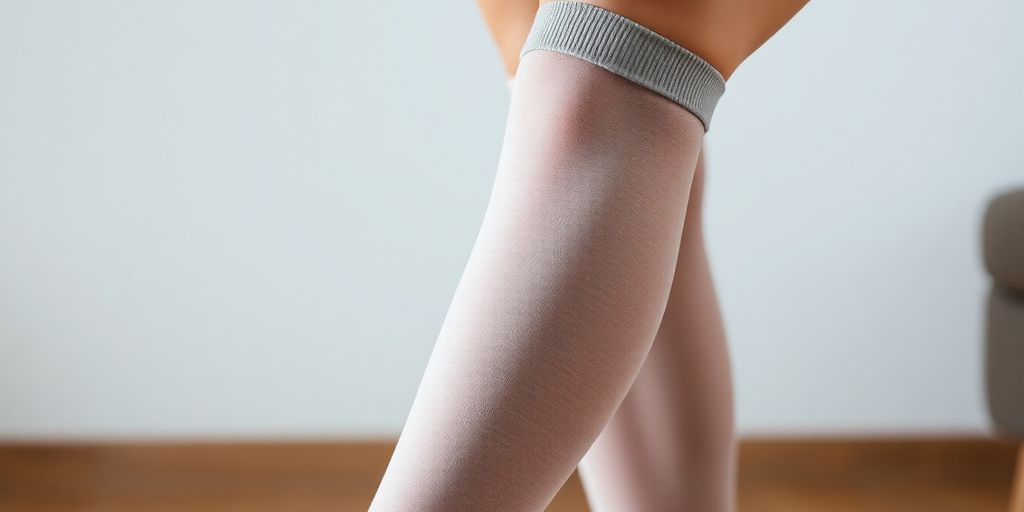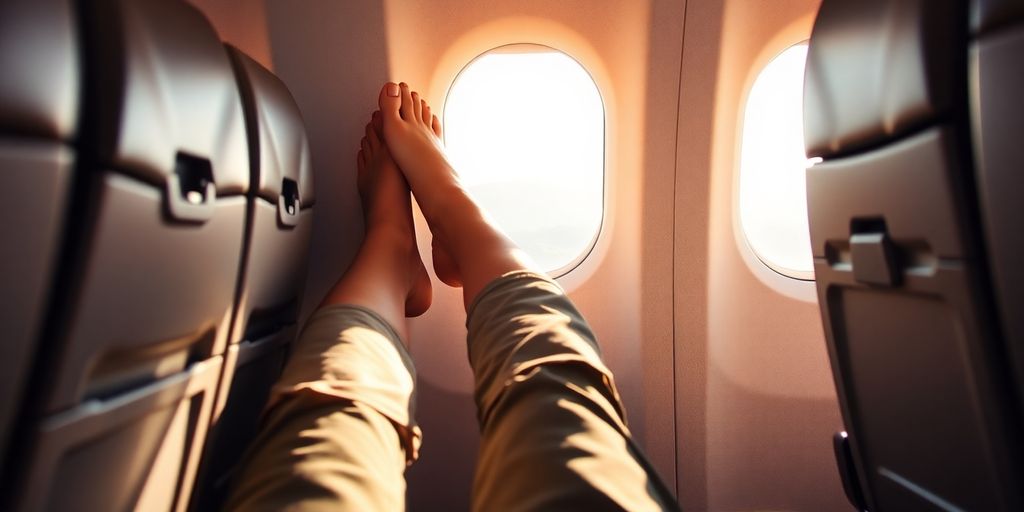Lymphedema is a condition where fluid builds up, causing swelling, usually in the arms or legs. It happens when your body's lymphatic system isn't working right. This system is super important for keeping you healthy, moving fluid, and fighting off sickness. When it gets messed up, fluid can just sit there, causing problems. Luckily, there are ways to manage lymphedema, and one of the most common and helpful methods involves compression.
Key Takeaways
- Lymphedema happens when your lymphatic system doesn't drain fluid properly, leading to swelling.
- Compression garments help push fluid out of swollen areas and keep it from building up again.
- Wearing compression consistently can reduce swelling, make you more comfortable, and prevent worse problems.
- There are different kinds of compression therapy, and a doctor can help you pick the right one for your lymphedema.
- Managing lymphedema often involves more than just compression, like exercise and special massages.
Understanding Lymphedema: What It Is and Why It Matters
The Lymphatic System: A Quick Overview
Okay, so lymphedema is all about the lymphatic system not working right. Think of the lymphatic system as your body's drainage system. It's a network of vessels and nodes that carry lymph fluid, which is basically fluid containing waste and immune cells. When this system gets blocked or damaged, fluid builds up, leading to swelling. It's like a traffic jam on the highway, but instead of cars, it's fluid, and instead of a highway, it's your lymphatic vessels. This can happen for a bunch of reasons, and it's not something to ignore.
Causes and Risk Factors of Lymphedema
Lymphedema can be classified as primary or secondary. Primary lymphedema is lymphedema that’s caused by a lymphatic system issue that’s present at birth or inherited, while secondary lymphedema is the more common form. Secondary lymphedema can occur as a result of cancer, cancer treatment, chronic venous insufficiency, physical trauma, obesity, and more.
There are a handful of risk factors for lymphedema, so getting a professional diagnosis is important. Your doctor can help you determine the best treatment plan for your lymphedema, including whether compression garments are a safe treatment option for you. In many cases, lymphedema treatment is focused on stimulating the lymphatic system to drain excess fluid and finding relief from your symptoms.
Lymphedema can really mess with your life. It's not just about swelling; it can lead to discomfort, reduced mobility, and even skin changes. Ignoring it can make things worse, so understanding the causes and risk factors is the first step in managing it effectively.
The Role of Compression in Lymphedema Management

How Compression Garments Work
When lymph fluid pools in tissues, it leads to swelling and discomfort. Compression gear applies steady, even pressure to the skin. Compression gear uses steady, gentle pressure to push lymph fluid along its natural route. It’s not magic—just physics plus a snug fit.
- Creates a pressure gradient from the furthest point back toward the trunk
- Supports muscle contractions to boost fluid movement
- Limits fluid buildup by reducing capillary leakage
| Garment Type | Pressure Range (mmHg) |
|---|---|
| Low compression | 20–30 |
| Medium compression | 30–40 |
| High compression | 40–50 |
A properly fitted garment worn daily can really change how your limb feels.
In many cases, patients use compression wraps for lymphedema to target stubborn pockets of fluid. These wraps layer over one another to guide lymph along its path.
Types of Compression Therapy for Lymphedema
There are several ways to add pressure:
- Medical-grade stockings and sleeves (see special stockings or wraps)
- Multi-layer bandaging applied by a therapist or self-applied at home
- Pneumatic compression pumps that inflate and deflate to mimic natural movement
Each option has its own routine for wear time and care. Your doctor or therapist will help you pick what fits your daily life.
Benefits of Consistent Compression Use
Reducing Swelling and Discomfort
Consistent use of compression garments is a cornerstone in managing lymphedema. The primary benefit is a noticeable reduction in swelling within the affected limb. This happens because the external pressure provided by the garment assists the lymphatic system in draining excess fluid. Think of it like gently squeezing a sponge to get the water out. This reduction in fluid volume directly translates to decreased discomfort, heaviness, and pain often associated with lymphedema. Over time, consistent compression can lead to a significant improvement in the patient's overall comfort and mobility. It's not a cure, but it's a powerful tool for symptom management. For example, compression garments prevent fluid accumulation, which reduces swelling and discomfort.
Preventing Complications and Progression
Beyond immediate symptom relief, consistent compression plays a vital role in preventing long-term complications and the progression of lymphedema. Lymphedema, if left unmanaged, can lead to a cascade of issues, including:
- Increased risk of skin infections (cellulitis)
- Fibrosis (hardening of the tissues)
- Chronic inflammation
- Reduced limb function
Regular compression helps maintain the integrity of the lymphatic system, preventing further damage and slowing down the disease's advancement. It's about proactively managing the condition to maintain a better quality of life in the long run. Think of it as preventative maintenance for your lymphatic system. By consistently supporting lymphatic drainage, compression helps to avoid the negative consequences of fluid buildup and tissue damage. It's a long-term strategy for managing lymphedema and preserving limb health.
Choosing the Right Compression for You

Selecting the appropriate compression therapy is a critical step in managing lymphedema effectively. It's not a one-size-fits-all situation; what works for one person might not be suitable for another. Factors like the severity of your lymphedema, the affected area, and your overall health play significant roles in determining the best course of action. Let's explore some key considerations.
Consulting with Healthcare Professionals
The most important step in choosing the right compression is to consult with a healthcare professional. This usually means a doctor or a certified lymphedema therapist. They can properly assess your condition and recommend the most appropriate type and level of compression.
Trying to self-diagnose or select compression garments without professional guidance can be risky. Incorrect compression can actually worsen your condition or lead to other complications.
Here's what you can expect during a consultation:
- A thorough medical history review.
- Physical examination of the affected area.
- Measurements to determine the correct size and fit.
- Discussion of your lifestyle and activity level.
They'll consider all these factors to recommend the best compression garments for your needs. Remember, finding the right fit and pressure is essential for effective lymphedema management.
Living Well with Lymphedema: Beyond Compression
While compression is a cornerstone of lymphedema management, it's important to remember that a holistic approach is key to improving your quality of life. Think of compression, whether through compression socks for lymphedema or compression sleeves for lymphedema, as one piece of a larger puzzle.
Living with lymphedema means more than just wearing special clothes. It's about finding smart ways to feel better every day. Discover simple tips and tricks to improve your life with lymphedema. You can also find great deals on products that help by checking out our coupons.
Wrapping Up: Compression Garments for Lymphedema
Lymphedema is a long-term problem where fluid builds up, causing swelling because the lymphatic system isn't working right. Sometimes, people are born with it, but often it happens later, maybe after cancer treatment. Doctors often suggest compression clothes to help with the swelling and other symptoms. These special clothes put steady pressure on the swollen area. This helps move the fluid, gets blood flowing better, and generally helps the fluid drain. Devices like the Flexitouch Plus, which use air pressure, can be another option if regular compression garments aren't enough. These devices are made for different body parts and gently squeeze and release to help with swelling and pain. If you want to get a handle on your symptoms at home, talk to your lymphedema specialist. They can tell you more about options like Flexitouch Plus and if it's a good fit for you.
Frequently Asked Questions
What exactly is lymphedema?
Lymphedema is a problem where fluid builds up, causing swelling. This happens when your body's drainage system, called the lymphatic system, isn't working right. This system usually helps get rid of bad stuff and fight sickness. When it's blocked or damaged, fluid gets stuck in your body's tissues.
How do compression garments help with lymphedema?
Compression garments are special clothes that gently squeeze your skin. This helps move the extra fluid and makes your blood flow better. Doctors or special therapists can tell you which ones to use to help with lymphedema. You can find sleeves for arms, socks, full body suits, and more.
How do compression garments actually work?
These garments work by putting steady pressure on the swollen area. This pressure helps stop fluid from building up, gets your blood moving, and pushes the fluid along. Think of it like gently squeezing a sponge to get water out.
Are there different kinds of compression therapy?
Yes, there are different kinds! Besides regular compression clothes, there are also special bandages that wrap around the swollen area. Another type is a pneumatic compression device, like the Flexitouch Plus system. These use air to gently squeeze your body, which helps move the fluid.
What are the main benefits of using compression?
Wearing compression helps a lot. It makes swelling go down and makes you more comfortable. It also stops things from getting worse and helps prevent problems like skin infections. It can even make it easier to move around.
How do I pick the right compression garment for me?
It's super important to talk to your doctor or a lymphedema specialist. They can figure out what's best for you, measure you correctly, and make sure you get the right type of compression. Everyone is different, so a custom plan is key.
Are there any special rules for wearing or caring for compression garments?
Yes, keeping your compression garments clean is important to prevent skin problems. Also, most garments meant for daytime use shouldn't be worn while you sleep. Your specialist will give you all the details on how to care for them and when to wear them.
Will compression therapy completely cure my lymphedema?
Lymphedema is a long-term problem. While compression helps a lot, your doctor might also suggest other things like special exercises, a type of massage called manual lymph drainage, and other ways to reduce swelling. It's often a mix of treatments that works best.




Share:
Finding Relief: How Chronic Venous Insufficiency Compression Socks Can Improve Your Leg Health
Finding Lymphedema Compression Relief: A Comprehensive Guide